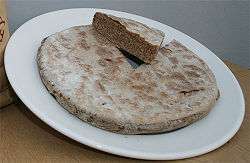Bere (grain)
Bere, pronounced "bear," is a six-row barley currently cultivated mainly on 5-15 hectares of land in Orkney, Scotland. It is also grown in Shetland, Caithness and on a very small scale by a few crofters on some of the Western Isles, i.e. North Uist, Benbecula, South Uist, Islay and Barra. It is probably Britain's oldest cereal in continuous commercial cultivation.[1]



Bere is a landrace adapted to growing on soils of a low pH and to a short growing season with long hours of daylight, as found in the high latitudes of northern Scotland. It is sown in the spring and harvested in the summer. Because of its very rapid growth rate it is sown late but is often the first crop to be harvested. It is known locally as "the 90-day barley."[2][3]
Etymology
Originally bere or beir or bear was a generic Lowland Scots word for barley of any kind, and was used throughout the country. Now it is used mainly in the north of Scotland.[4][5][6] It often referred to barley of a lower yield, and the phrase "bear meal marriage" usually meant one that would not bring much wealth with it.[7] Talking of the wide variety of crops in England, and crop rotation, Professor T.C. Smout writes: "In Scotland, there is no evidence of such variation possibly because the range of crops was so much smaller — often only oats or bear (a primitive form of barley)".[5]
History
Bere is a very old grain that may have been brought to Britain by Vikings in the 8th century or even from an earlier wave of settlement. In its early days it was also called "bygge" or "big," probably originating from bygg, the Old Norse term for barley. It became well-adapted to the far north of Britain as successive generations of farmers grew it, selecting each year's seeds from the best plants of the previous year.[8][1]
In the 19th and early 20th centuries, bere was an important crop in the Highlands and Islands region of Scotland, providing grain for milling and malting and straw for thatching and animal bedding. It was also exported from Orkney and other ports in Scotland to Northern Europe. The advent of higher-yielding barley varieties led to a deep decline in bere growing during the 19th and 20th centuries. It survives in cultivation today thanks to Barony Mills, a 19th-century watermill, which purchases the grain to produce beremeal which is used locally in bread, biscuits, and the traditional beremeal bannock.[1]
Research
The Agronomy Institute at Orkney College UHI in Scotland has had a research programme on Bere since 2002. The programme is aimed at developing new markets for the crop and developing best practices for growing it more easily and with increased yield. As a result of this research, several new markets (whisky, beer and biscuits) have been developed for Orkney Bere. The crop is also being grown on the island of Islay, for whisky production by Bruichladdich Distillery.
Research at the James Hutton Institute has shown that bere is particularly able to grow in alkaline soils with low metal micronutrients.[9]
Alcoholic beverages
Bere has a long history of use in making alcoholic beverages. Historical accounts from the 15th century onward show that Orkney produced large amounts of malt and beer, most of it probably from bere. An ancient tradition of making bere-based homebrew survives until this day on the island. During the 19th century, the Campbeltown distilleries used large quantities of bere in making Scotch whisky. In the early 21st century some distillers began experimenting again with bere, and in 2006, the UK's most northern brewery released a bere-based microbrew.[11]
References
- Martin, Peter; Xianmin Chang (June 2008). "Bere Whisky: rediscovering the spirit of an old barley". The Brewer & Distiller International. 4 (6): 41–43. Retrieved 2011-06-21.
- The Scottish Government, ed. (2002). "Chapter 14: A Detailed Review of the Contribution Made to Biodiversity by Scots Bere". The Status of Traditional Scottish Animal Breeds and Plant Varieties and the Implications for Biodiversity. The Scottish Government. Retrieved 2008-11-14.
- Theobald, H. E.; et al. (2006). "The nutritional properties of flours derived from Orkney grown bere barley (Hordeum vulgare L.)". British Nutrition Foundation Nutrition Bulletin (31): 8–14.
- "Dictionary of the Scots Language: "DSL - SND1 BEAR, BERE, Beer, Bar"". Archived from the original on 2011-05-26. Retrieved 2008-11-19.
- Smout, T.C. (1972) A History of the Scottish People 1560-1830 p114
- "Dictionary of the Scots Language: "DSL - DOST Bere, Beir"". Archived from the original on 2011-05-26. Retrieved 2008-11-19.
- "Dictionary of the Scots Language: "DSL - SNDS BEAR"". Archived from the original on 2011-05-26. Retrieved 2008-11-19.
- Jarman, R.J. (1996). "Bere barley - a living link with 8th Century?". Plant Varieties and Seeds. 9: 191–196.
- "Understanding the living heritage of bere barley for a more sustainable future". www.hutton.ac.uk. The James Hutton Institute. 11 July 2017.
- Martin, Peter; Wishart, John; Cromarty, Arthur; Chang, Xianmin (2009). "European Landraces Bioversity International Technical Bulletin No.15" (PDF). University of the Highlands and Islands.
- Martin, Peter; Xianmin Chang (June 2007). "Bere and Beer: Growing old cereals on northern islands". The Brewer & Distiller International. 3 (6): 27. Retrieved 2008-11-14.
